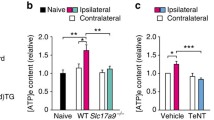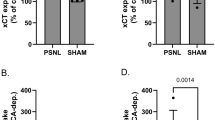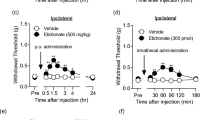Abstract
Zinc enriched (ZEN) neurons and terminals are abundant in the rodent spinal cord. Zinc ions have been suggested to modulate the excitability of primary afferent fibers believed to be important in nociceptive transmission. To test the hypothesis that vesicular zinc concentration is related to neuropathic pain we applied Chung’s rodent pain model on BALB/c mice, and traced zinc transporter 3 (ZnT3) proteins and zinc ions with immunohistochemistry and autometallography (AMG), respectively. Under anesthesia the left fifth lumbar spinal nerve was ligated in male mice in order to produced neuropathic pain. The animals were then sacrificed 5 days later. The ZnT3 immunoreactivity was found to have decreased significantly in dorsal horn of fourth, fifth, and sixth lumbar segments. In parallel with the depressed ZnT3 immunoreactivity the amount of vesicular zinc decreased perceptibly in superficial gray matters of especially layer I-IV of the same segments. The transection-induced reduction of vesicular zinc in ZEN terminals of the dorsal horn was synchronic to reduced pain threshold, as measured by von Frey method. In a separate study, we observed intensive zinc selenite precipitation in somata of the smaller spinal ganglion cell, but 5 days after spinal nerve transection zinc precipitation was also found in the lager ganglion cells. The present results indicate that zinc may be involved in pain mechanism in the spinal ganglion level. These results support the hypothesis that vesicular zinc might have a modulatory role for neuropathic pain. Thus, increased pain sensitivity might be related to reduce vesicular zinc level in the dorsal spinal gray matter.





Similar content being viewed by others
References
Aniksztejn L, Charton G, Ben-Ari Y (1987) Selective release of endogenous zinc from the hippocampal mossy fibers in situ. Brain Res 404:58–64
Assaf SY, Chung SH (1984) Release of endogenous Zn2+ from brain tissue during activity. Nature 308:734–736
Beaulieu C, Dyck R, Cynader M (1992) Enrichment of glutamate in zinc-containing terminals of the cat visual cortex. Neuroreport 3:861–864
Busselberg D, Michael D, Evans ML, Carpenter DO, Haas HL (1992) Zinc (Zn2+) blocks voltage gated calcium channels in cultured rat dorsal root ganglion cells. Brain Res 593:77–81
Chaplan SR, Bach FW, Pogrel JW, Chung JM, Yaksh TL (1994) Quantitative assessment of tactile allodynia in the rat paw. J Neurosci Methods 53:55–63
Choi YB, Lipton SA (1999) Identification and mechanism of action of two histidine residues underlying high-affinity Zn2+ inhibition of the NMDA receptor. Neuron 23:171–180
Christensen MK, Frederickson CJ (1998) Zinc-containing afferent projections to the rat corticomedial amygdaloid complex: a retrograde tracing study. J Comp Neurol 400:375–390
Cole TB, Wenzel HJ, Kafer KE, Schwartzkroin PA, Palmiter RD (1999) Elimination of zinc from synaptic vesicles in the intact mouse brain by disruption of the ZnT3 gene. Proc Natl Acad Sci USA 96:1716–1721
Danscher G (1982) Exogenous selenium in the brain. A histochemical technique for light and electron microscopical localization of catalytic selenium bonds. Histochemistry 76:281–293
Danscher G (1996) The autometallographic zinc-sulphide method. A new approach involving in vivo creation of nanometer-sized zinc sulphide crystal lattices in zinc-enriched synaptic and secretory vesicles. Histochem J 28:361–373
Danscher G, Stoltenberg M (2005) Zinc-specific autometallographic in vivo selenium methods: tracing of zinc-enriched (ZEN) terminals, ZEN pathways, and pools of zinc ions in a multitude of other ZEN cells. J Histochem Cytochem 53:141–153
Danscher G, Howell G, Perez-Clausell J, Hertel N (1985) The dithizone, Timm’s sulphide silver and the selenium methods demonstrate a chelatable pool of zinc in CNS. A proton activation (PIXE) analysis of carbon tetrachloride extracts from rat brains and spinal cords intravitally treated with dithizone. Histochemistry 83:419–422
Danscher G, Stoltenberg M, Bruhn M, Sondergaard C, Jensen D (2004) Immersion autometallography: histochemical in situ capturing of zinc ions in catalytic zinc-sulfur nanocrystals. J Histochem Cytochem 52:1619–1625
Danscher G, Jo SM, Varea E, Wang Z, Cole TB, Schroder HD (2001) Inhibitory zinc-enriched terminals in mouse spinal cord. Neuroscience 105:941–947
Frederickson CJ, Danscher G (1990) Zinc-containing neurons in hippocampus and related CNS structures. Prog Brain Res 83:71–84
Frederickson CJ, Kasarskis EJ, Ringo D, Frederickson RE (1987) A quinoline fluorescence method for visualizing and assaying the histochemically reactive zinc (bouton zinc) in the brain. J Neurosci Methods 20:91–103
Frederickson CJ, Suh SW, Silva D, Thompson RB (2000) Importance of zinc in the central nervous system: the zinc-containing neuron. J Nutr 130:1471S–1483S
Gingrich KJ, Burkat PM (1998) Zn2+ inhibition of recombinant GABAA receptors: an allosteric, state-dependent mechanism determined by the gamma-subunit. J Physiol 506(Pt 3):609–625
Holm IE, Andreasen A, Danscher G, Perez-Clausell J, Nielsen H (1988) Quantification of vesicular zinc in the rat brain. Histochemistry 89:289–293
Howell GA, Frederickson CJ (1990) A retrograde transport method for mapping zinc-containing fiber systems in the brain. Brain Res 515:277–286
Howell GA, Welch MG, Frederickson CJ (1984) Stimulation-induced uptake and release of zinc in hippocampal slices. Nature 308:736–738
Jo SM, Danscher G, Daa Schroder H, Won MH, Cole TB (2000) Zinc-enriched (ZEN) terminals in mouse spinal cord: immunohistochemistry and autometallography. Brain Res 870:163–169
Kim SH, Chung JM (1992) An experimental model for peripheral neuropathy produced by segmental spinal nerve ligation in the rat. Pain 50:355–363
Kozma M, Szerdahelyi P, Kasa P (1981) Histochemical detection of zinc and copper in various neurons of the central nervous system. Acta Histochem 69:12–17
Larson AA, Kitto KF (1997) Manipulations of zinc in the spinal cord, by intrathecal injection of zinc chloride, disodium-calcium-EDTA, or dipicolinic acid, alter nociceptive activity in mice. J Pharmacol Exp Ther 282:1319–1325
Larson AA, Kitto KF (1999) Chelation of zinc in the extracellular area of the spinal cord, using ethylenediaminetetraacetic acid disodium-calcium salt or dipicolinic acid, inhibits the antinociceptive effect of capsaicin in adult mice. J Pharmacol Exp Ther 288:759–765
Larson AA, Giovengo SL, Shi Q, Velazquez RA, Kovacs KJ (2000) Zinc in the extracellular area of the central nervous system is necessary for the development of kainic acid-induced persistent hyperalgesia in mice. Pain 86:177–184
Li C, Peoples RW, Weight FF (1997) Inhibition of ATP-activated current by zinc in dorsal root ganglion neurones of bullfrog. J Physiol 505(Pt 3):641–653
Liu T, Walker JS, Tracey DJ (1999) Zinc alleviates thermal hyperalgesia due to partial nerve injury. Neuroreport 10:1619–1623
Ma JY, Zhao ZQ (2001) The effects of Zn2+ on long-term potentiation of C fiber-evoked potentials in the rat spinal dorsal horn. Brain Res Bull 56:575–579
Mancini M, Ricci A, Amenta F (1992) Age-related changes in sulfide-silver staining in the rat neostriatum: a quantitative histochemical study. Neurobiol Aging 13:501–504
Martinez-Guijarro FJ, Soriano E, Del Rio JA, Lopez-Garcia C (1991) Zinc-positive boutons in the cerebral cortex of lizards show glutamate immunoreactivity. J Neurocytol 20:834–843
Mook Jo S, Kuk Kim Y, Wang Z, Danscher G (2002) Retrograde tracing of zinc-enriched (ZEN) neuronal somata projecting to the olfactory bulb. Brain Res 956:230–235
Palmiter RD, Cole TB, Quaife CJ, Findley SD (1996) ZnT-3, a putative transporter of zinc into synaptic vesicles. Proc Natl Acad Sci USA 93:14934–14939
Paoletti P, Ascher P, Neyton J (1997) High-affinity zinc inhibition of NMDA NR1-NR2A receptors. J Neurosci 17:5711–5725
Perez-Clausell J, Danscher G (1985) Intravesicular localization of zinc in rat telencephalic boutons. A histochemical study. Brain Res 337:91–98
Perez-Clausell J, Danscher G (1986) Release of zinc sulphide accumulations into synaptic clefts after in vivo injection of sodium sulphide. Brain Res 362:358–361
Peters S, Koh J, Choi DW (1987) Zinc selectively blocks the action of N-methyl-D-aspartate on cortical neurons. Science 236:589–593
Quinta-Ferreira ME, Matias CM (2005) Tetanically released zinc inhibits hippocampal mossy fiber calcium, zinc and synaptic responses. Brain Res 1047:1–9
Rubio ME, Juiz JM (1998) Chemical anatomy of excitatory endings in the dorsal cochlear nucleus of the rat: differential synaptic distribution of aspartate aminotransferase, glutamate, and vesicular zinc. J Comp Neurol 399:341–358
Safieh-Garabedian B, Poole S, Allchorne A, Kanaan S, Saade N, Woolf CJ (1996) Zinc reduces the hyperalgesia and upregulation of NGF and IL-1 beta produced by peripheral inflammation in the rat. Neuropharmacology 35:599–603
Schroder HD (1977) Sulfide silver architectonics of rat, cat, and guinea pig spinal cord. A light microscopic study with Timm’s method for demonstration of heavy metals. Anat Embryol (Berl) 150:251–267
Schroder HD (1979) Sulfide silver stainability of a type of bouton in spinal cord motoneuron neuropil: an electron microscopic study with Timm’s method for demonstration of heavy metals. J Comp Neurol 186:439–450
Schroder HD, Danscher G, Jo SM, Su H (2000) Zinc-enriched boutons in rat spinal cord. Brain Res 868:119–122
Smeets WJ, Perez-Clausell J, Geneser FA (1989) The distribution of zinc in the forebrain and midbrain of the lizard Gekko gecko. A histochemical study. Anat Embryol (Berl) 180:45–56
Sorensen JC, Slomianka L, Christensen J, Zimmer J (1995) Zinc-containing telencephalic connections to the rat striatum: a combined Fluoro-Gold tracing and histochemical study. Exp Brain Res 105:370–382
Takeda A, Hirate M, Tamano H, Oku N (2003) Release of glutamate and GABA in the hippocampus under zinc deficiency. J Neurosci Res 72:537–542
Takeda A, Minami A, Seki Y, Oku N (2004) Differential effects of zinc on glutamatergic and GABAergic neurotransmitter systems in the hippocampus. J Neurosci Res 75:225–229
Vogt K, Mellor J, Tong G, Nicoll R (2000) The actions of synaptically released zinc at hippocampal mossy fiber synapses. Neuron 26:187–196
Wang Z, Li JY, Dahlstrom A, Danscher G (2001a) Zinc-enriched GABAergic terminals in mouse spinal cord. Brain Res 921:165–172
Wang Z, Danscher G, Mook Jo S, Shi Y, Daa Schroder H (2001b) Retrograde tracing of zinc-enriched (ZEN) neuronal somata in rat spinal cord. Brain Res 900:80–87
Wang ZY, Stoltenberg M, Huang L, Danscher G, Dahlstrom A, Shi Y, Li JY (2005) Abundant expression of zinc transporters in Bergman glia of mouse cerebellum. Brain Res Bull 64:441–448
Wenzel HJ, Cole TB, Born DE, Schwartzkroin PA, Palmiter RD (1997) Ultrastructural localization of zinc transporter-3 (ZnT-3) to synaptic vesicle membranes within mossy fiber boutons in the hippocampus of mouse and monkey. Proc Natl Acad Sci USA 94:12676–12681
Westbrook GL, Mayer ML (1987) Micromolar concentrations of Zn2+ antagonize NMDA and GABA responses of hippocampal neurons. Nature 328:640–643
Xie X, Smart TG (1994) Modulation of long-term potentiation in rat hippocampal pyramidal neurons by zinc. Pflugers Arch 427:481–486
Author information
Authors and Affiliations
Corresponding author
Rights and permissions
About this article
Cite this article
Jo, S.M., Danscher, G., SchrØder, H.D. et al. Depletion of vesicular zinc in dorsal horn of spinal cord causes increased neuropathic pain in mice. Biometals 21, 151–158 (2008). https://doi.org/10.1007/s10534-007-9103-x
Received:
Accepted:
Published:
Issue Date:
DOI: https://doi.org/10.1007/s10534-007-9103-x




